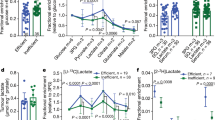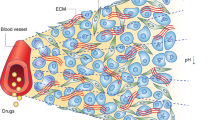Abstract
Investigations were carried out on two lines of human melanomas (MF; n = 12 and EE; n = 13) xenografted in nude mice. The tumours were characterised by a similar vascular supply but showed a pronounced difference in the rate of volume growth and in the radiobiologically hypoxic fraction. The distribution of ATP, glucose and lactate in the tumours was investigated using quantitative bioluminescence and single photon imaging. Concentrations of the metabolites were obtained as global values for the entire tumour mass, in regions with densely packed, structurally intact tumour cells ('viable zones'), in areas with necrosis, stromal cells and fibrous material ('necrotic zones') and in adjacent normal tissue. In all melanomas investigated glucose concentrations were significantly lower and lactate concentrations were significantly higher than in normal tissue. In contrast, no significant differences for ATP were detected. ATP and glucose concentrations were significantly less in necrotic than in viable tumour zones, whereas lactate concentrations were nearly equal in these tumour parts. Corresponding results were obtained in central versus peripheral tumour zones. There was no dependency of global or regional metabolite concentrations on tumour size within the volume range 110-1470 mm3. Based on this lack of dependency, metabolic concentrations were averaged over the whole tumour size range. Metabolite concentrations were not significantly different either globally or regionally between the two tumour entities investigated, a finding which held true for all three metabolites registered. Thus, metabolite distributions apparently mirror the similarity in vascularity of MF and EE melanomas rather than reflecting intrinsic properties with regard to tumour growth rates or susceptibility to radiation.
This is a preview of subscription content, access via your institution
Access options
Subscribe to this journal
Receive 24 print issues and online access
$259.00 per year
only $10.79 per issue
Buy this article
- Purchase on Springer Link
- Instant access to full article PDF
Prices may be subject to local taxes which are calculated during checkout
Similar content being viewed by others
Author information
Authors and Affiliations
Rights and permissions
About this article
Cite this article
Kroeger, M., Walenta, S., Rofstad, E. et al. Growth rates or radiobiological hypoxia are not correlated with local metabolite content in human melanoma xenografts with similar vascular network. Br J Cancer 72, 912–916 (1995). https://doi.org/10.1038/bjc.1995.432
Issue Date:
DOI: https://doi.org/10.1038/bjc.1995.432



